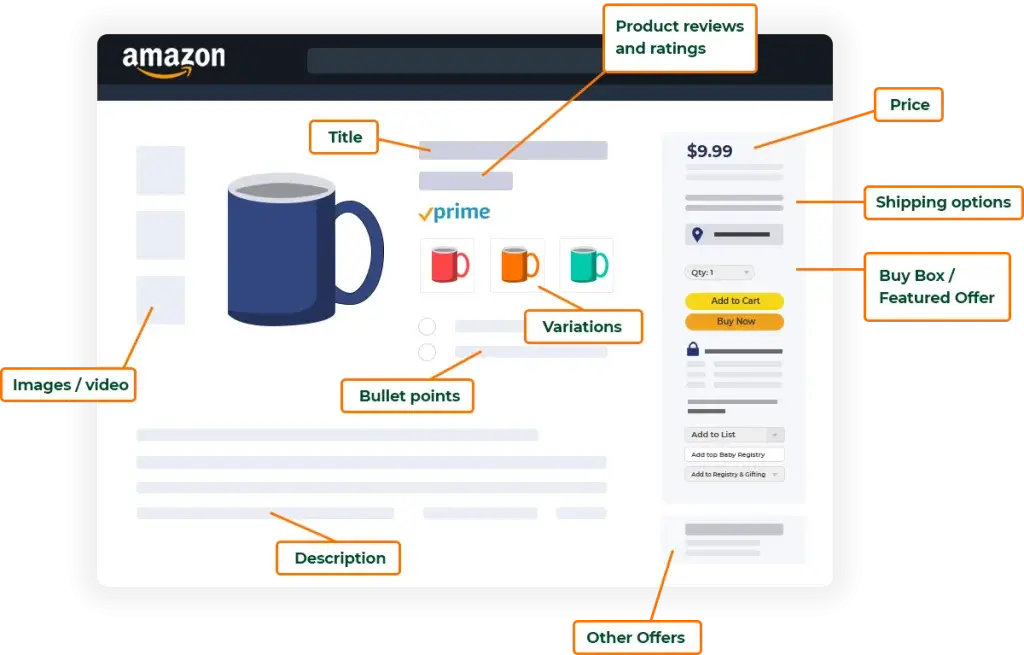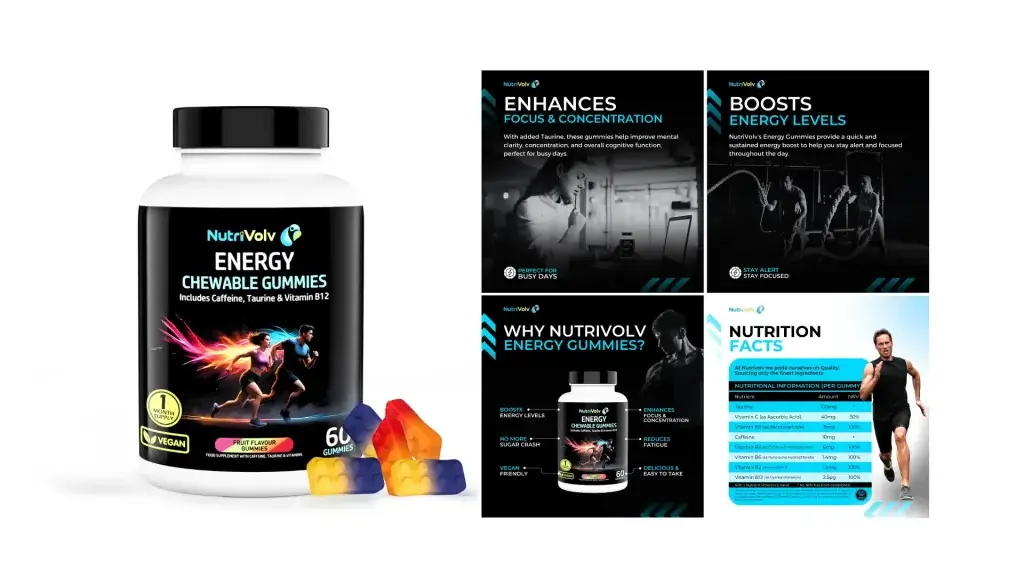In a competitive Amazon marketplace, simply listing your products isn’t enough to attract shoppers or secure sales. If your listings aren’t optimized, you risk losing visibility and falling in rankings. That’s where understanding how to improve Amazon rankings with SEO becomes essential.
By applying effective Amazon SEO strategies, you can increase your product’s visibility, attract more shoppers, and ultimately drive more sales.
This guide walks you through simple steps to improve your Amazon rankings through SEO, showing you proven tactics that make your products stand out. Ready to see your listings climb? Let’s get started with the strategies that can give you an edge over the competition.
What is Amazon SEO and Why is It Important for Product Rankings?
Amazon SEO, or Search Engine Optimization, is a way to make your products more visible in Amazon’s search results, helping them get noticed by potential buyers. While SEO might typically remind you of Google, it’s highly relevant on Amazon, where shoppers are ready to buy.

In fact, 56% of U.S. consumers begin their product searches directly on Amazon. Optimizing for Amazon’s search engine isn’t just nice to have—it’s essential for success on the platform.
Why Amazon SEO Matters for Sellers
Amazon SEO is critical because it enables sellers to connect with ready-to-buy customers by improving their listings’ visibility. With strong Amazon SEO, you can:
- Boost Visibility: Higher-ranking products appear at the top of search results, making it easy for shoppers to find them.
- Drive More Sales: Increased visibility means more clicks, which leads to more purchases from interested customers.
- Reduce Ad Costs: Good Amazon SEO can generate organic traffic, reducing the need to rely solely on paid advertising for visibility.
A9: The Core of Amazon SEO
At the heart of Amazon SEO is its A9 algorithm, which Amazon developed to show the most relevant products based on customer search queries. This algorithm prioritizes “revenue per click” by surfacing products most likely to convert into sales.
Here’s what A9 takes into account:
- Relevance: Keywords in titles and descriptions tell the algorithm what your product is about, helping match it to the right search terms.
- Pricing & Availability: Competitive pricing and in-stock products perform better as they improve the shopping experience.
- Sales & Reviews: Strong sales and positive reviews are favored, showing customers that the product is trusted and frequently bought.
Amazon SEO isn’t just about keywords; it’s about aligning your listing with A9’s focus on relevancy, value, and trustworthiness. When done right, Amazon SEO helps sellers reach the right audience and ultimately drive sales, building a strong presence in a highly competitive marketplace.
How Amazon SEO Works: 5 Key Elements
Here’s a streamlined look at the primary factors Amazon uses to match your products with interested shoppers.
1. Customer Searches and Keywords
Amazon’s search bar is the entry point for most shoppers. When they type in a term, Amazon prioritizes results based on keyword relevance. Using precise, relevant keywords in your titles and descriptions is crucial for making sure your products appear in these searches.
2. Search Filters for Refined Results
Shoppers often narrow their options using filters such as price, ratings, delivery speed, and category. If your listing details align well with popular filters, your products are more likely to be seen by customers, fine-tuning their search.
3. Product Listing Quality and Placement
When customers browse search results, product quality becomes vital. Listings with strong visuals, accurate descriptions, competitive pricing, and good reviews have a greater chance of drawing clicks. This is where compelling content and quality images can make a difference.
4. Amazon’s Best Sellers and Sales Rank
Amazon assigns a Best Sellers Rank (BSR) to top-selling items, which is updated in real-time. Products with high sales ranks gain better visibility as they demonstrate popularity and relevance, encouraging more clicks and potential sales.
5. Sponsored Ads for Enhanced Visibility
Amazon offers Sponsored Products ads that boost product placement in search results for relevant keywords. These ads are pay-per-click, so you only pay when someone interacts with your ad, making it a cost-effective way to increase product visibility.
Amazon SEO: 7 Steps to Improve Amazon Rankings
Here are seven effective strategies to improve Amazon rankings with SEO that can enhance your product visibility and boost sales on Amazon.
- Conduct keyword research
- Optimizing Product Titles
- Bullet Points Optimization
- Product Descriptions
- High-Quality Product Images
- Add back-end search terms
- Adjust product prices to drive sales
1. Conduct Keyword Research
To improve Amazon rankings, start by conducting comprehensive keyword research. Identifying the exact words and phrases potential customers use to search for products like yours is essential.
Start by entering various keywords in the Amazon search bar and take note of the suggestions that appear; these can reveal trending search terms.

Additionally, analyze your competitors’ listings for effective keywords they are using. Tools like Amazon’s Product Opportunity Explorer can provide valuable insights into search volumes and trends.

Remember to use a mix of short-tail and long-tail keywords. While short-tail keywords like “shoes” might have high search volume, long-tail keywords such as “men’s waterproof hiking shoes” can drive higher conversion rates by targeting specific customer needs.
2. Craft High-Performing Product Titles
Another vital element in your quest to improve Amazon rankings is crafting high-performing product titles. Your title should include primary keywords identified during your research.
Aim for an informative and concise title that encompasses essential details such as product type, brand name, and key attributes like color or size.
For instance, instead of simply listing “Pillow Cases,” opt for “Good Sleep Collection, Blue Pillow Cases (Set of 2).” This approach not only captures attention but also provides vital information.
While Amazon allows up to 200 characters for product titles, keeping your title around 60 characters is recommended for clarity and impact.
3. Create Informative Product Descriptions
Your product description is a golden opportunity to elaborate on features and benefits while using secondary keywords. This section should provide crucial details such as materials, sizes, care instructions, and warranty information.
Avoid the pitfall of keyword stuffing, as it can negatively affect both customer experience and your rankings. Instead, focus on weaving in keywords naturally and maintaining a conversational tone.
If you’ve used a key phrase once, you don’t need to repeat it; instead, diversify your vocabulary to keep your content fresh and engaging.
4. Highlight Key Details with Bullet Points
Utilizing bullet points effectively is another strategy to improve Amazon rankings. This format allows you to highlight key product features and enhance customer understanding.
When creating bullet points, focus on the most important details you want to stand out, such as design, unique features, or specific uses.
Start each bullet with a brief descriptor followed by a concise explanation. Keeping each point under 100 characters ensures quick readability and better engagement.
5. Add Back-End Search Terms
To further improve Amazon rankings, don’t forget to utilize back-end search terms. These keywords are not visible to customers but can significantly influence search rankings.
To add these terms, log in to your Amazon Seller Central account and navigate to the product details section. Use this space for synonyms, abbreviations, and alternative names that might not fit in the visible areas of your listing.

When entering back-end keywords, remember to keep them lowercase and separate with spaces, avoiding unnecessary articles or prepositions.
6. Showcase High-Quality Product Images
High-quality product images are essential for engaging customers and conveying important product details. Aim to include a variety of images that show your product from different angles and highlight its key features.

Using plain white backgrounds and ensuring that your images are clear and well-lit can make a significant difference. Additionally, don’t overlook the importance of “alt-text.”
This invisible text describes your images and can include relevant keywords, further helping you improve Amazon rankings with SEO while enhancing accessibility for visually impaired customers.
For expert tips on creating images that convert, check out our guide on How to Create Amazon Product Images and discover how optimized visuals can drive more sales.
7. Adjust Product Prices to Drive Sales
Finally, competitive pricing is crucial for boosting your sales and rankings on Amazon. Research to determine the price range of similar products in your niche.
Use Amazon’s Revenue Calculator to help you find a pricing sweet spot that ensures profitability while remaining attractive to buyers.
Consider employing Amazon’s Automate Pricing feature, which can help keep your prices competitive across your listings. By strategically adjusting your prices, you can increase sales, which positively impacts your rankings over time.
Other Amazon Tools for Growing Sales
In addition to SEO, Amazon provides a range of tools designed to help sellers grow their sales, improve Amazon rankings, and build customer trust. Here’s a breakdown of some essential tools that can complement your SEO efforts and elevate your Amazon business.
1. Amazon Brand Analytics
Amazon Brand Analytics offers valuable data on customer search behavior, top search terms, demographics, and buying trends.
This tool helps sellers understand which keywords drive the most traffic and conversions so you can refine listings and adjust your SEO strategies to improve Amazon rankings and target the right audience effectively.
2. Amazon A+ Content
A+ Content enables sellers enrolled in the Brand Registry to enhance their product listings with richer descriptions, videos, and high-quality images.

By showcasing your product’s unique features and benefits, A+ Content can make listings more attractive, helping to boost conversion rates and, in turn, improve organic rankings on Amazon.
3. Amazon Vine Program
The Vine Program connects sellers with Amazon’s trusted reviewers to get early, unbiased feedback on their products.

Positive Vine reviews can increase credibility, helping to build trust and influence purchase decisions, which can lead to higher rankings, as Amazon values customer satisfaction and engagement in its ranking algorithm.
4. Fulfillment by Amazon (FBA)
FBA makes products eligible for Prime shipping, a key factor in search ranking. With FBA, Amazon handles storage, shipping, customer service, and returns, giving customers a seamless experience.
FBA also allows sellers to focus on business growth while leveraging Amazon’s logistics, boosting both sales and customer satisfaction, which can contribute positively to product rankings.
Curious about the long-term value of using FBA? Check out our guide, Is Selling on Amazon FBA Still Worth It?, for insights on how FBA can impact your business growth and if it’s the right fit for you.
5. Manage Your Experiments (A/B Testing)
Amazon’s Manage Your Experiments tool allows sellers to test different versions of their product titles, images, and descriptions through A/B testing.
By identifying the content that resonates best with customers, sellers can optimize their listings to increase conversions, which Amazon’s algorithm takes into account when determining rankings.
6. Amazon Sponsored Ads
Sponsored Ads can significantly increase the visibility of your listings by placing them at the top of search results and other high-traffic areas. Using targeted keywords, Sponsored Ads drive more traffic to your products, potentially boosting sales.
As sales increase, so does the likelihood of improved rankings through Amazon’s algorithm, which favors products with consistent sales activity.
7. Seller University
Seller University provides a comprehensive library of resources and tutorials on topics ranging from SEO optimization to fulfillment best practices.
These resources guide sellers through Amazon’s platform, helping you make informed decisions about optimizing listings, improving customer satisfaction, and maximizing sales potential.
8. Amazon’s Automated Pricing Tool
To stay competitive, Amazon’s Automated Pricing tool lets sellers adjust prices in real-time. Sellers can set rules to automatically match or beat competitor prices, helping win the Buy Box, a key factor in increasing visibility and sales. By keeping prices competitive, this tool supports higher rankings and consistent sales growth.
9. Customer Feedback Manager
The Customer Feedback Manager consolidates reviews and customer feedback, allowing you to monitor and respond to customer comments. Addressing feedback promptly and improving product quality based on reviews can lead to higher ratings, build trust, and ultimately contribute to better rankings on Amazon.
Improve Amazon Rankings: Conclusion
In today’s competitive marketplace, leveraging Amazon SEO is essential to Improve Amazon Rankings and boost your product’s visibility. By optimizing product listings, using strategic keywords, and refining your pricing, you can elevate your brand above competitors and reach more potential customers.
At Techload, we specialize in optimizing Amazon listings to help sellers maximize their rankings and sales. Ready to give your listings a competitive edge? Let Techload help you make the most of Amazon’s search algorithm!
How to Improve Amazon Rankings: FAQs
Amazon SEO is the process of optimizing product listings with keywords and engaging content to increase their visibility in Amazon search results, leading to higher sales potential.
To improve your product’s rank, refine your category, optimize your listing, set competitive prices, use ads effectively, and prioritize customer engagement.
Yes, Amazon SEO uses keyword optimization and strategic listing enhancements to improve product visibility in search results, making your products easier for shoppers to find.
Collecting positive customer reviews and ratings helps boost ranking by building trust and credibility for your product.
Yes, A+ Content improves the shopping experience, which can lead to higher conversions and sales, ultimately enhancing SEO and visibility.
Yes, Brand-Registered sellers can access Amazon Brand Analytics for data on top search terms, catalog performance, and search queries to refine keyword strategies.
The Product Opportunity Explorer helps sellers spot keyword trends within their niche, offering insights into popular terms to help listings perform better.






2 Responses